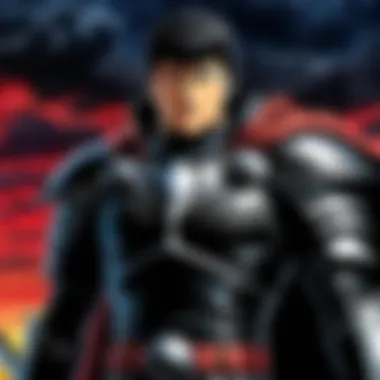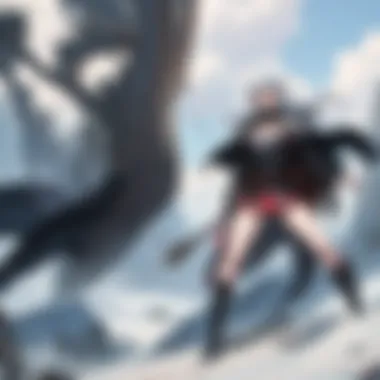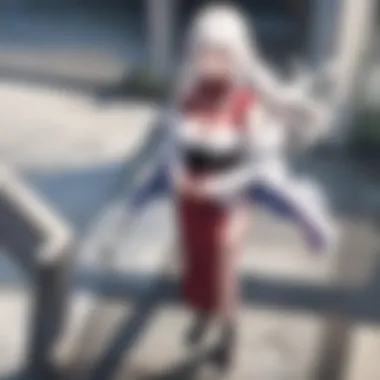Berserk Season 1 (2016): An In-Depth Analysis


Preface to the Series
Berserk Season 1, released in 2016, marks a significant entry into the long-standing legacy of the Berserk franchise, originally created by Kentaro Miura. The anime is classified within the dark fantasy genre, where it delves deep into themes surrounding despair, ambition, and the human condition. At its core, the series follows the journey of Guts, a mercenary with immense strength and a tragic past, as he navigates a dark world filled with demons, betrayal, and an overwhelming thirst for revenge.
The release of this adaptation followed the acclaimed original manga that began serialization in 1989. While the manga has garnered immense popularity for its intricate story and detailed artwork, the 2016 adaptation faced both anticipation and scrutiny from fans. Some viewed it as a chance to bring Miura's world to a new generation, while others were concerned about the potential loss of depth in the transition from page to screen.
In terms of popularity, Berserk has maintained a cult status well beyond its original release. The manga has sold millions of copies worldwide, while the anime adaptations remain a topic of discussion among enthusiasts. The series is often heralded for its complex characters and moral ambiguity but has also faced criticism for its graphic content and pacing, notable issues that the 2016 adaptation continues to grapple with.
"Berserk’s significance lies in its ability to explore themes that resonate deeply with the struggles of humanity, despite its fantastical elements.”
Through this analysis, we will explore various facets of Berserk Season 1, including its production background, character development, thematic exploration, and how it resonates within the broader context of anime culture.
Prologue to Berserk Season
The release of Berserk Season 1 in 2016 marked a significant moment in anime history, particularly for fans of the dark fantasy genre. This adaptation revitalized interest in Kentaro Miura's original manga, which has significantly influenced the medium since its debut in 1989. Given the deep themes and complex characters inherent in Berserk, understanding the intricacies of this season is crucial for both newcomers and long-term fans alike.
One key aspect to consider is the narrative structure that the anime employs. The storytelling in Berserk is not linear; it explores the life and struggles of Guts, a lone mercenary battling both external foes and his own inner demons. By diving into this character-driven approach, viewers gain insight into themes of conflict, ambition, and the human condition. This exploration sets the tone for the relationship between Guts and the world around him, effectively translating dense narrative elements from the manga to the screen.
Additionally, seasonal adaptations often differ in their execution of art and production techniques. Berserk Season 1 faced criticism for its animation quality, but it also brought new audiences to the franchise. Dirty and gritty visuals reflect the harsh realities of Guts's journey, even if the execution sometimes falls short of expectations. Analyzing these artistic choices reveals not only the creators' intent but also helps us understand the emotional engagement they aim for with the audience.
The implications of this season extend beyond the confines of its episodes. It sparked discussions regarding adaptation fidelity, where fans debated the merits of this portrayal compared to earlier versions of the story. This discourse emphasizes the importance of acknowledging how adaptations can shape perceptions of source material, especially in a franchise as revered as Berserk.
Historical Context of the Berserk Franchise
Understanding the historical context of the Berserk franchise is essential for grasping its narrative depth and enduring appeal. This section provides a vital foundation for evaluating Berserk Season 1, released in 2016. The rich history informs the adaptations, influences, and thematic elements that resonate with audiences. When considering how previous works have shaped the 2016 anime, it becomes clear that knowledge of its origins can enhance the viewing experience, making it more rewarding.
Overview of the Original Manga
The original Berserk manga was created by Kentaro Miura and first published in 1989. It quickly gained recognition for its intricate storytelling and detailed artwork. Miura’s narrative is marked by a unique blend of dark fantasy and psychological drama, centered around the character of Guts. The manga delves into heavy themes such as sacrifice, ambition, and the nature of evil, which have become crucial elements in the overall franchise.
Miura's world is harsh. His characters are deeply flawed, struggling against insurmountable odds. This approach has earned Berserk a dedicated fanbase, as readers connect with the complexity of its arcs. Each volume introduces layers of lore that build the narrative's richness.
Previous Adaptations
Before the release of Berserk Season 1 in 2016, the franchise had seen several adaptations, each interpreting Miura's work in different ways. In the late 1990s, an animated series aired, which aimed to capture the essence of the manga but faced limitations in terms of pacing and character development.
In 2012, a trilogy of films was released. These films had higher production quality than the earlier series. However, they also faced criticism for skipping crucial segments of the manga that are critical for understanding the character progression and relationships.
Each adaptation serves as a reference point for the 2016 series. Fans often compare the latest season with earlier versions. The 2016 adaptation aimed to address some shortcomings, utilizing modern animation techniques. Yet, it still grappled with the complexities inherent in adapting such a layered source material.
Overall, the historical context of Berserk serves not just to highlight its past but to inform and influence current and future adaptations. The evolution of the franchise, from its manga origins to various adaptations, showcases a narrative that demands respect and careful examination.
"Understanding the roots of Berserk is key to appreciating its complexity and narrative strength."
Production Insights
The production of Berserk Season 1 serves as a foundation for understanding its overall impact and significance in the realm of anime. This section will delve into various elements, from the studio and talented individuals involved to budget considerations and animation techniques. Each aspect plays a vital role in the final product, illuminating the creative choices made in bringing this complex narrative to life.
Studio and Staff Involvement


Berserk Season 1 was produced by GEMBA and Millepensee, two studios that approached this adaptation with a specific vision. GEMBA aimed to grasp the essence of the original manga while infusing it with their distinct stylistic flair. The director, Mitsuo Hirata, brought his experience to the table, striving to remain faithful to the source material. Many key staff members had previous experience in the anime industry, which benefited the show's production quality.
Key members of the production include:
- Mitsuo Hirata: Director and lead guiding figure of the adaptation.
- Shinji Takamatsu: Contributing as character designer, responsible for retaining the features fans recognized from the manga.
- Blumhouse Animation: Audio production, which ensured that voices aligned with characters’ personalities.
The collaboration among these professionals added depth and care into the show's execution, showcasing a commitment to upholding the original legacy of Berserk.
Budget Considerations
When discussing any animated series, budget considerations are a crucial element to understand its outcome. The allocated budget for Berserk Season 1 influenced many factors from the quality of animation to voice acting. With a limited budget, it was a challenge to translate the intricate manga illustrations into animated form without compromising the story.
Additionally, the series faced restrictions that affected the animation frame rate and detail:
- Limited resources often necessitate focusing on key scenes rather than an overall consistent quality.
- Strategic cuts may lead to less polished scenes, causing some viewers to notice variances in quality.
These financial constraints shaped underlying decisions that made their mark on the viewing experience.
Animation Style and Techniques
The animation style chosen for Berserk Season 1 diverged from previous adaptations, with a blend of traditional and CGI animation techniques that aimed to resonate with a modern audience. This hybrid approach attempted to capture the dark aesthetic associated with the Berserk universe yet brought its own set of challenges.
Prominent elements in the animation style included:
- Character Design: Staying true to Kentaro Miura's original character designs while modernizing them for animation clarity.
- 3D CGI Elements: Utilized for certain battle scenes to enhance grandiosity but received mixed reception from fans.
- Art Direction: Dark color palettes and stark contrasts were utilized to reflect the manga's tone and atmosphere.
This approach raised debates within the community about the balance between technological advancements and the need for solid narrative animation, prompting varied audience reactions.
"Animation should serve the story, not overshadow it. The challenge lies in finding that delicate balance."
Ultimately, the production insights of Berserk Season 1 reveal an intricate dance of creativity, budget limitations, and innovative animation techniques, all of which are crucial for appreciating the series as a significant contribution to both the Berserk franchise and anime as a whole.
Character Analysis
Character analysis is a fundamental aspect of understanding Berserk Season 1 (2016). The depth of each character drives the narrative, making their development crucial to the story. By dissecting the characters, viewers can appreciate the intricacies of their motivations, choices, and relationships. Each character embodies distinct themes and struggles, which resonate throughout the anime. Analyzing these elements enhances the experience and appreciation for fans, providing insight into the broader implications of the story. The characters are not mere figures in a plot; they represent complex human emotions and conflicts.
Guts: The Protagonist’s Journey
Guts, the central figure of the series, presents an archetype of resilience and conflict. His journey begins in the merciless battlefield, shaped by a past filled with trauma and betrayal. Guts is marked by physical strength and a relentless spirit, symbolizing the struggle against insurmountable odds. Yet his character is not simply about brute force. Throughout the series, he grapples with existential questions about purpose and ambition.
Guts' relationship with his massive sword, the Dragon Slayer, reflects the weight of his burdens. It is a weapon forged from pain and loss, much like Guts himself. This weapon signifies not just his ability to fight, but also his psychological struggle. The journey of Guts reveals how each encounter, whether friend or foe, influences his path towards understanding his own humanity. This complexity makes Guts one of the most intriguing protagonists in modern anime.
Casca: A Complex Character
Casca adds a rich layer to the narrative, embodying both strength and vulnerability. Initially introduced as a skilled warrior in the Band of the Hawk, she showcases leadership and tenacity. Her relationship with Guts complicates her character further, illustrating themes of love and sacrifice.
Casca's inner turmoil becomes evident as she confronts her feelings for Guts against her loyalty to Griffith. This duality makes her both relatable and tragic, as she must navigate the harsh realities of a world rife with conflict. Her experiences shed light on the often unspoken roles women play in violent narratives, challenging traditional tropes in anime. By analyzing Casca's character, viewers gain a deeper understanding of the emotional stakes involved in Guts' journey.
Griffith: The Antagonist’s Depth


Griffith stands as a compelling antagonist, possessing charisma and ambition that contrast sharply with Guts’ raw strength. His vision for power and greatness drives the narrative tension and adds gravitas to the story. Griffith’s character explores the idea of ambition and the cost that comes with it.
His transformation from a noble commander to a questionable leader unfolds complexities that challenge simple notions of good and evil. Griffith’s actions, especially his betrayal of Guts and the Band of the Hawk, serve as a pivotal moment in the series, encapsulating themes of betrayal and sacrifice. His manipulative nature sparks questions about morality and the price of greatness, making him a thought-provoking character.
Understanding Griffith’s motivations enriches the viewer's engagement with the series, as it provokes contemplation on the moral ambiguities that life presents.
"The intricacies of character motivations in Berserk transcend typical narratives, inviting audiences into a maze of ethical dilemmas and personal choices."
Themes and Motifs
The exploration of themes and motifs is crucial in understanding the depth of Berserk Season 1. The narrative intertwines complex philosophical ideas with raw human experiences, illuminating the struggles of the individual against a harsh world. By analyzing these themes, viewers gain insight into the protagonist's journey and the moral conflicts presented throughout the series. Each motif adds layers of meaning and resonates with the audience, making it compelling for anime and manga enthusiasts.
Fate vs Free Will
The theme of fate versus free will serves as a central pillar in the narrative. Guts, the protagonist, embodies the struggle against predetermined destiny. He often finds himself caught in situations beyond his control. This reflects a broader question: to what extent do we shape our paths in life? The interactions between Guts and other characters, such as Griffith, highlight contrasting philosophies about destiny. Griffith’s ambition suggests an acceptance of fate, relying on it to manipulate those around him. Thus, the audience is forced to consider the implications of choices and the consequences they carry. This theme not only drives the plot but also engages viewers in existential inquiry about agency and autonomy.
Betrayal and Trust
Betrayal and trust run parallel to the core of the character relationships within Berserk. Guts’ relationship with Griffith is complex, layered with trust that is ultimately subverted. The series showcases how betrayal can lead to profound personal transformation and suffering. For Guts, betrayal from a trusted ally forces him to question the very nature of trust. This motif emerges in various forms, drawing attention to how trust is essential but can also be a source of vulnerability. The narrative suggests that the bonds we form can be both empowering and destructive. The emotional impact of these betrayals resonates throughout the series, enforcing the notion that trust is both a fragile and powerful aspect of human connections.
Survival and Resilience
The motif of survival and resilience is prevalent throughout Berserk Season 1. Guts’ journey is painted against a backdrop of brutality and despair, representing the human will to persist in the face of overwhelming odds. His battles are not only physical confrontations but also metaphors for internal struggles. The harsh environments and monsters Guts faces reflect his inner turmoil and relentless pursuit of purpose. This theme resonates with viewers who have experienced struggles, offering a portrayal of resilience as a vital human trait. It underscores a nuanced understanding of survival—not just physically, but emotionally and psychologically as well. In a world filled with existential threats, Guts’ relentless spirit serves as a powerful message about the necessity of resilience in our own lives.
Sound Design and Score
In any anime, sound design and score play a crucial role. They enhance the viewing experience. In the case of Berserk Season 1 (2016), these elements are vital for establishing atmosphere. The audio elements find a way to support the complex themes and emotional depth of the story. Without a strong sound design, the impact of key scenes would be diminished.
Composer's Vision
The composer for Berserk Season 1 is Susumu Hirasawa. He is known for his unique blend of electronic and orchestral music. Hirasawa's approach to the score reflects the darker themes of the anime. His music is not just a backdrop; it mirrors the turbulent journey of Guts. Each piece captures the essence of conflict and despair.
Hirasawa draws from various influences. He incorporates traditional Japanese sounds and modern electronic techniques. This combination gives the score a distinct feel. The music often builds tension effectively and enhances emotional scenes.
"Music doesn't merely accompany the visuals; it elevates them to new heights."
The opening theme, Inferno, sets the tone right from the start. It features intense rhythms and haunting melodies. These elements evoke feelings of unease and anticipation. The viewer is quickly pulled into the series' dark world. The ending theme is more reflective. It allows for a moment of introspection after the emotional highs of each episode.
Impact of Sound on Narrative
The impact of sound design on the narrative of Berserk cannot be understated. Sound cues are crucial for delivering emotional weight. They guide viewer reactions throughout the series. For instance, silence during pivotal moments speaks volumes. It allows the audience to digest key events.
Each clash of swords or roar of a creature is deliberately crafted. These sound effects heighten tension. The audience feels each battle's intensity. The design of the sound helps to bring the harsh world of Berserk to life.
In addition, the use of sound can signify character development. For example, the changes in Guts' theme throughout the season reflect his emotional journey. When he is filled with rage, the music grows intense. During moments of despair, the tones soften. This progression shows how deeply sound influences storytelling.
Overall, sound design and score are not simply technical components. They are integral to experiencing Berserk Season 1. The thoughtful composition and sound choices enhance the narrative, turning the anime into a richer, more impactful experience.
Critical Reception


The critical reception of Berserk Season 1 (2016) offers invaluable insights into how the adaptation was perceived by audiences and critics alike. It helps to gauge its impact within the larger framework of anime adaptations of popular manga. Understanding viewer reactions, critical reviews, and comparisons with other seasons contributes to a comprehensive understanding of the work’s legacy. This section explores these elements in detail.
Viewer Reactions
Viewer reactions to Berserk Season 1 were quite mixed. Some fans of the original manga expressed disappointment with the anime's animation quality and pacing. Many highlighted their expectations based on the manga's deep storytelling and visually striking art style, which they felt were not fully realized in the animated format. The blend of CGI and traditional animation styles received criticism as appearing jarring, detracting from the overall immersion of the series.
However, there were also positive reactions. New viewers appreciated the dark themes and complex characters that were brought to life, even if the execution faced scrutiny. This contrast shows how different audiences engage with the same material based on prior familiarity and personal expectations.
"The series introduces Guts and his harrowing journey, yet many felt the animation did not do justice to the emotional depth of the story."
Critical Reviews
Critical reviews were polarized. Some reviewers lauded the series for its ambition in adapting a legendary manga. They noted the attempt to tackle themes of fate, despair, and resilience, which remained intact. On the other hand, numerous reviews pointed out notable flaws in storytelling and pacing. Critics emphasized that the development of secondary characters suffered due to rushed narrative elements.
Moreover, various publications focused on specific aspects, such as the score by Susumu Hirasawa, which did receive acclaim as it added layers of atmosphere to key moments. Many critiques discussed how previous adaptations might have left a shadow over the reception, noting that expectations were set high from the onset.
Comparative Analysis with Other Seasons
When comparing Berserk Season 1 to other adaptations, particularly the 1997 anime series and the film trilogy released earlier, distinctive differences emerge. The 1997 series is often praised for its art style and emotional depth, securing a nostalgic place in the hearts of long-time fans. Critics argue that it delivered a more coherent narrative and a stronger focus on character relationships.
In contrast, Berserk Season 1 aimed for modern production values, but this led to varying interpretations of crucial scenes. The film trilogy's attempt to compress a vast narrative into fewer episodes received flak for pacing issues. The 2016 adaptation attempted a unique visual approach, trying to merge traditional with digital animation but did not resonate as well with all audiences.
In summary, analyzing the critical reception allows fans and newcomers alike to understand the complexities inherent in adapting beloved source material into animated form. This multi-faceted view encourages a deeper appreciation for the struggles and triumphs of conveying a unique story like Berserk.
Cultural Impact
The cultural impact of Berserk Season 1 extends far beyond its immediate viewership and influences the landscape of anime as a whole. This section aims to elucidate the factors that contribute to its significance, including its thematic depth, character complexities, and animation style. These elements resonate with both audiences and creators alike, sparking discussions around storytelling techniques and artistic approaches in contemporary anime.
Influence on Modern Anime
Berserk demonstrates a unique fusion of deep narrative and striking visual style, which has influenced many modern anime titles. The show tackles themes of tragedy, ambition, and existential struggle, setting a precedent for darker storytelling in anime.
Many recent series borrow character archetypes and thematic motifs from Berserk. For example, the use of flawed heroes engaged in morally ambiguous battles can be seen in series like Attack on Titan and Vinland Saga. This approach challenges audiences to consider the ethical dimensions of their narratives, inspired by Berserk's complex portrayals of both heroes and villains.
Berserk also sets benchmarks in animation style. Its atmospheric tone and unique visuals serve as a reference point for creators aiming to evoke similar emotional responses. Additionally, the use of shadow and texture in animation was remarkably ahead of its time, providing a template that many contemporary animators strive to emulate. The impact is evident not only in narrative structure but also in the visual aspects of anime today.
Fan Community Response
The response from the fan community has been both passionate and critical. Following its release, Berserk Season 1 garnered a dedicated fanbase, keen on discussing its intricacies, from character development to philosophical themes. Online discussions often take place on platforms like Reddit, where fans analyze character arcs and draw comparisons to the original manga.
A notable point of contention among fans revolves around the adaptation choices made in the anime. Many viewers expressed disappointment in the animation quality in certain episodes, particularly when compared to the manga's art. Despite this, the series still generated substantial debate and analysis, illustrating the commitment of its audience.
Fans have also created a variety of content inspired by Berserk, from fan art to in-depth essays. This engagement signifies not just admiration for the series, but also the desire to explore its themes more thoroughly.
"Berserk has ignited discourse on trauma, ambition, and fate, influencing both storytelling and artistic visions across the anime genre."
Ending and Future Prospects
The conclusion section of this article serves as a critical reflection on the significance of Berserk Season 1. It ties together the various themes, production elements, and character dynamics discussed throughout the piece. This summation not only encapsulates the essence of the anime but also paves the way for understanding its future trajectory and relevance within the anime community.
Final Thoughts on Season One
Anticipation for Future Installments
Looking forward, there is a palpable excitement surrounding future installments of the Berserk series. Fans are eager to see how the adaptation will handle subsequent arcs of the narrative, especially given the emotional heft and intricacies that lie ahead. The anticipation is particularly focused on the development of Griffith's character and his complex relationship with Guts and Casca. Furthermore, there is hope that animation studios will apply lessons learned from Season 1 to enhance production quality in future seasons, particularly in the portrayal of fight sequences and emotional scenes. The potential for new story arcs to unfold adds a layer of interest and speculation among the fan community. Ultimately, the future of Berserk is a topic that will continue to engage its audience, enriching discussions across various platforms like Reddit and among dedicated fan groups on social media.















